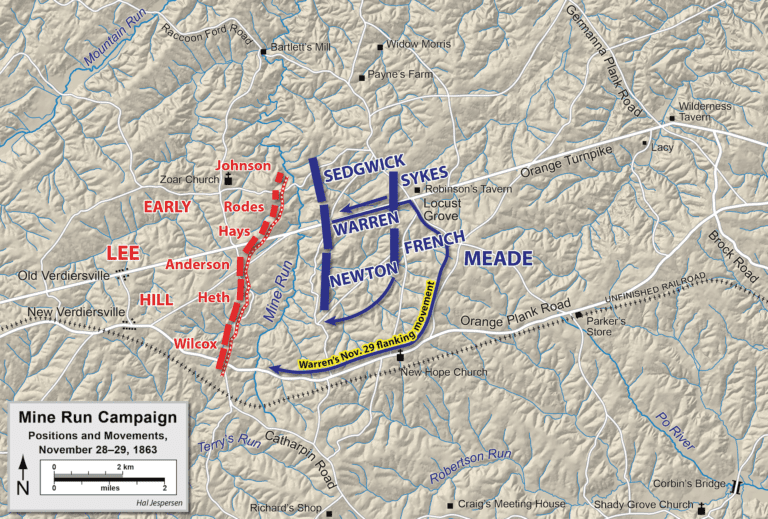The Battle of Mine Run took place on November 26-December 1, 1863, and was part of the Forgotten Fall of 1863. An echo of Fredericksburg would lead to the moral courage of Union Gen. George Gordon Meade.
Located in Orange County, 3 miles west of the Wilderness battlefield, only the action at Payne’s Farm is preserved by The American Battlefield Trust, with the rest of the battlefield waiting to be preserved. Notable sites include Robinson’s Tavern and New Hope Church.
This is one of the lesser-known battles of the American Civil War and part of the Forgotten Fall of 1863. Under enormous pressure after Gettysburg to land a decisive blow against Gen. Robert E. Lee, Union General George Gordon Meade launched one last campaign before the approach of winter.
After the Battle of Gettysburg, both armies ended up back in Virginia, where they played a cat-and-mouse game up and down the Orange and Alexandria Railroad. On November 7, 1863, the Union army overwhelmed the Confederate line along the Rappahannock River at Rappahannock Station and Kelly’s Ford. The Federals took Culpeper County, while Gen. Robert E. Lee withdrew safely behind the Rapidan River in Orange County.
As the temperatures started to fall, Gen. Meade was compelled to take action and match the success of Gen. Grant out west – this is how he would silence his critics. Finding that Gen. Lee’s army was divided, he intended to cross the Rapidan River at numerous sites out of reach from the rebels and rapidly move on the Confederate flank.
On November 26, 1863, the first National Day of Thanksgiving, Meade launched his last campaign of the year. After two days of heavy rain, and with the river swollen, the Union army had pontoon crossing problems and lost a day trying to get the army across. This cost the Federals a large portion of their speed and surprise.
The Federal rendezvous point was at Robinson’s Tavern. Once Gen. Warren’s Corps made it there on November 27, 1863, he found Confederates under Gen. Jubal Early in his front.
This will start the battle known as Mine Run. Federals to his left and right had not come up, and he decided not to bring on a general engagement until he was reinforced.
Meanwhile, Union Gen. French was to get bogged down in the Wilderness region, moving up from Jacob’s Ford on Warren’s right. Due to Federal delays and confusion, they ran into a Confederate force near Payne’s Farm. An intense action erupted where some of the heaviest casualties were seen. With neither side getting a clear advantage, darkness called off the fight.
The next day on November 28, 1863, a combined Federal force pressed forward, finding no Confederates in sight. Once they reached Mine Run creek, they found Gen. Lee’s army on the other side along a ridgeline where they constructed earthwork fortifications with artillery placed in every advantageous position. It was Fredericksburg, or worse, exclaimed some Union soldiers.
The only option Gen. Meade had was an idea Gen. Warren came up with: to march a large Union force to Gen. Lee’s right flank where there was no creek or earthwork defense. On November 29, 1863, Gen. Warren marched his force and got into position for a morning attack the next day.
On November 30, 1863, Gen. Warren awoke to prepare for an assault, only to find rebels in his front. After learning about this Federal movement from rebel cavalry, Gen. Lee shifted his reserve overnight. With a Union barrage already underway, Gen. Warren would call off his flank attack and refuse to attack unless Gen. Meade gave him a direct order.
Seeing the futility for himself upon arrival, Gen. Meade called off the entire attack, which only promised death and destruction. While he lost his last opportunity before Grant would go out east, Gen. George Gordon Meade’s moral courage would earn his men’s undying affection as he chose their lives over his own career ambitions.
With no clear opportunity, on December 1, 1863, Gen. Meade started to withdraw back to Culpeper and cross the Rapidan River. The Army of the Potomac immediately went into winter quarters with dreams of a spring campaign in 1864. The actions at Mine Run were inconclusive, with 1,300 Union and 700 Confederate casualties.

Ready to explore the battlefield for yourself? Browse our full selection of American Civil War Battlefield Tours.
Please contact us if you have any questions about our tours or services.